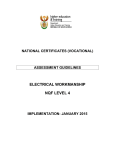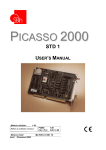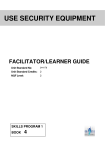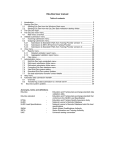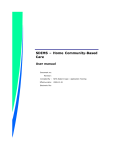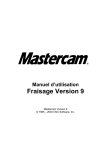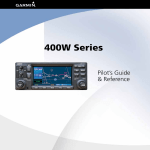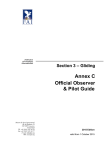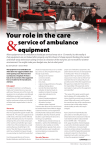Download FITTING AND TURNING NQF LEVEL 4
Transcript
NATIONAL CERTIFICATES (VOCATIONAL) SUBJECT GUIDELINES FITTING AND TURNING NQF LEVEL 4 IMPLEMENTATION: JANUARY 2015 Fitting and Turning Level 4 Subject Guidelines (January 2015) National Certificate (Vocational) INTRODUCTION A. What is Fitting and Turning about? Fitting and Turning is practiced by individuals in a trade-related occupation (career artisans) and within the broader sub-field of Manufacturing, Engineering and Related Technology. Individuals in this occupation need to apply a wide range of mechanical technology and skills, namely, in machining, installation, maintenance, repair, overhaul, assembly of machinery, associated equipment and mechanical sub-systems. Fitter and Turners, as they are called, are utilised in the manufacturing, mining, transport, food, chemical, petro-chemical and electrical power industries. They help to develop and expand the national and global economy. B. Why is Fitting and Turning important in the Engineering Studies learning programme? Fitting and Turning brings the range of mechanical technologies to the practical reality of maintenance and repair of machines, associated equipment and mechanical subsystems. Through its application, Fitting and Turning expands from its traditional skills base into new mechanical technologies derived from the mechanical engineering discipline. C. The link between Fitting and Turning Learning Outcomes and the Critical and Developmental Outcomes Thinking and problem-solving skills: Identify and solve problems in which responses display that responsible decisions using critical and creative thinking have been made. Use different functions and make corrective adjustments in problematic situations. Independence and self-management skills: Organise and manage oneself and one’s activities responsibly and effectively. Plan sequences of operations based on job instructions and adjust equipment appropriately. Research skills: Collect, analyse, organise and critically evaluate information. Examine work pieces for Turning and non-conformance with specifications. Measure work pieces for accuracy. Learning skills: Reflect on and explore a variety of strategies to learn more effectively. Gain experience and knowledge through application of different machining. Employment seeking skills: Explore education and career opportunities. Acquire the confidence to succeed by understanding the practical application. Entrepreneurship: Develop entrepreneurial opportunities. Produce a sense of self worth through confidence. D. Factors that contribute to achieving Fitting and Turning Learning Outcomes A learning environment conducive to teaching and learning through effective student support, motivation, commitment, a positive attitude and emphasis on safety Department of Higher Education and Training Version 17_03_14 1 2 Exposure to the mechanical engineering technology environment that will stimulate interest in the subject Qualified and competent lecturers who will encourage students to develop their knowledge and skills Availability of appropriate workshop tools, measuring devices, machinery and equipment. Department of Higher Education and Training Fitting and Turning Level 4 Subject Guidelines (January 2015) National Certificate (Vocational) FITTING AND TURNING- LEVEL 4 CONTENTS 1. DURATION AND TUITION TIME 2. SUBJECT LEVEL OUTCOMES AND FOCUS 3. ASSESSMENT REQUIREMENTS 3.1. Internal assessment 3.2. External assessment 4. WEIGHTED VALUES OF TOPICS 5. CALCULATION OF FINAL MARK 6. PASS REQUIREMENTS 7. SUBJECT AND LEARNING OUTCOMES 7.1 Pumps 7.2 Compressors 7.3 Fluid power systems – Hydraulics 7.4 Fluid power systems - Pneumatics 7.5 Surface Grinder 7.6 Centre Lathe 7.7 Milling Machine 7.8 CNN Lathe (Turning) 7.9 CNC Milling RESOURCE NEEDS FOR THE TEACHING OF FITTING AND TURNING- LEVEL 4 7.1. Physical resources 7.2. Human resources 7.3. Other resources Department of Higher Education and Training Version 17_03_14 3 1. DURATION AND TUITION TIME This is a one-year instructional programme comprising 200 teaching and learning hours. The subject may be offered on a part-time basis provided the student meets all the assessment requirements. Students with special education needs (LSEN) must be catered for in a way that eliminates barriers to learning. 2 SUBJECT LEVEL OUTCOMES AND FOCUS SAQA QUALIFICATION 50441 A focus for Level 4 students is the need to emphasise the divergence of fluid power systems from CNC machining. The curriculum designers recommend that these topics are treated as areas of specialisation. Exit level Outcome 1: Develop skills in working with whole machine-systems including pumps, compressors and fluid power systems illustrating precision in machining skills. Associated Assessment Criteria: The ability to work with whole machine-systems including pumps, compressors and fluid power systems illustrating precision in machining skills is demonstrated Exit level Outcome 2: Develop knowledge related to fitting placed alongside the introduction of new levels of complexity in machining processes. Associated Assessment Criteria: Complex machining processes are performed while illustrating knowledge related to fitting processes. 3 ASSESSMENT Information on internal and external assessment provided in this document aims to inform, assist and guide lecturers to plan the effective teaching of the subject. The Assessment Guidelines accompanying this document provide detailed information for planning and conducting internal and external assessments. 3.1 Internal assessment (50 percent) Detailed information regarding internal assessment and moderation is outlined in the current Internal Continuous Assessment (ICASS) Guideline document provided by the Department of Higher Education and Training (DHET). 3.2 External assessment (50 percent) A national examination is conducted annually in October or November by means of a paper(s) set and moderated externally. A practical component, the Integrated Summative Assessment Task (ISAT), will be included in the external assessment. 4 Department of Higher Education and Training Fitting and Turning Level 4 Subject Guidelines (January 2015) National Certificate (Vocational) Detailed information regarding external assessment and moderation is outlined in the ‘National Policy on the Conduct, Administration and Management of the Assessment of the Assessment of the National Certificate Vocational’, Gazette Number 30287, dated 12 September 2007. 4 WEIGHTED VALUES OF TOPICS (Topic weighting and time allocation) *Teaching Hours Topics Weight % Duration (hrs) Theory (hrs) Practical (hrs) 1 Pumps 10% 20 8 12 2 Compressors 10% 20 8 12 3 Fluid Power Systems - Hydraulics 10% 20 8 12 4 Fluid Power Systems - Pneumatics 10% 20 8 12 5 Surface Grinder 10% 20 8 12 6 Centre Lathe 12% 25 10 15 7 Milling Machine 12% 25 10 15 8 CNC Lathe (Turning) 13% 25 10 15 9 CNC Milling 13% 25 10 15 100% 200 80 120 Total *Teaching Hours refers to the minimum hours required for face to face instruction and teaching. This excludes time spent on revision, tests and internal and external examinations and assessment. The number of allocated teaching hours is influenced by the topic weighting, complexity of the subject content and the duration of the academic year. 5 CALCULATION OF FINAL MARK Internal assessment mark: Student’s mark/100 x 50 = a mark out of 50 (a) Examination mark: Student’s mark/100 x 50 = a mark out of 50 (b) Final mark: (a) + (b) = a mark out of 100 All marks are systematically processed and accurately recorded to be available as hard copy evidence for, among others, reporting, moderation and verification purposes. 6 PASS REQUIREMENTS A student must obtain at least 50 percent in ICASS and 50 percent in the examination to achieve a pass in this subject. 7 SUBJECT AND LEARNING OUTCOMES On completion of Fitting and Turning Level 4, the student should have covered the following topics: Department of Higher Education and Training Version 17_03_14 5 Topic 1: Pumps Topic 2: Compressors Topic 3: Fluid Power Systems - Hydraulics Topic 4: Fluid Power Systems - Pneumatics Topic 5 Surface Grinding Topic 6 Centre Lathe Topic 7 Milling Machine Topic 8 CNC Lathe (Turning) Topic 9 CNC Milling Topic 1: Pumps Subject Outcome 1.1: Explain correct safety procedures and care when installing / maintaining pumps Range: Safety procedures include excerpts from the Driven Machinery Regulations. Safety measures include the impact on human beings, machines, equipment, materials and the environment. Pump maintenance safety includes the application of personal protective equipment, assembly, dismantling start-up procedures, protective guards and other best practice procedures. Always use the manufacturers’ service manual as a guide to the effective maintenance and installation procedures. Learning Outcomes: The student is able to: Explain worksite health and safety practices. Explain the importance of a clean working area and good housekeeping. Explain the safety precautions before and after replacing pump components. Describe the need for using the correct tools, equipment, cleaning materials and personal protective equipment. Subject Outcome 1.2: Demonstrate an understanding of pumps Range: Pump classifications include: Centrifugal pumps - both single and multi-stage pumps; Rotary pumps - gear pump, helical screw gear pump, vane pump and flexible impeller pump; Reciprocating pumps - piston pump, plunger pump and steam and air-driven reciprocating pumps Centrifugal pump terminology – casing, impeller, vortex, vacuum, stuffing box assembly, bearings, shaft assembly, inlet, outlet, single-stage and multi-stage, balancing disc. Reciprocating pump terminology - single and two-stage pumps; Single and double acting pumps, difference between plunger and piston, inlet and outlet valves, suction and delivery head, stuffing box assembly, plunger pump with external packing, plunger pump with internal packing, the application of air chambers and reasons for use. Rotary pumps inlet, outlet rotor, direction of flow, partial vacuum, vanes, eccentric cam. 6 Department of Higher Education and Training Fitting and Turning Level 4 Subject Guidelines (January 2015) National Certificate (Vocational) A clear differentiation between positive and non positive displacement pumps is required and application (with examples). Learning Outcomes: The student is able to: Explain the function of pumps and use pump terminology applicable to classification. Identify, name and explain the working principles of the three classifications of pumps. Explain the functions of various components from given drawings. Differentiate between positive and non positive displacement pumps and indicate where they are used. Subject Outcome 1.3: Plan and prepare for pump installation / maintenance. Learning Outcomes: The student is able to: Read and interpret job card, obtain documentation and interpret engineering drawings. Identify personnel requirements and schedule maintenance procedures. Select appropriate tools and equipment. Clean and inspect the complete assembly. List the potential areas of defect and wear. Isolate equipment electrically from other energy sources. Isolate equipment mechanically from other energy sources. Subject Outcome 1.4: Dismantle and assemble pumps Range: Dismantling and assembly is confined to a single stage centrifugal pump-type. Students are expected to recall pump faults including: Causes of pump slip, general maintenance, the elimination of end thrust, installation procedures, the reduction and elimination of water-hammer. Parts inspection is important at this stage Learning Outcomes: The student is able to: Disassemble the pump. Identify pump components. Remove the pump assembly Inspect parts for non-conformances. Clean parts. Assemble the pump and/or sub-components. Perform cleaning and overhaul procedures. Apply appropriate safety practices during the process. Subject Outcome 1.5: Perform quality checks and job completion procedures Learning Outcomes: The student is able to: Conduct quality checks. Measure and test replacement parts and evaluate performance. Accurately record information on completed job. Department of Higher Education and Training Version 17_03_14 7 Open a new file and name it or use an existing file, and store information in a safe place. Clean and maintain equipment and tools. Report on defective tools and equipment and facilitate discard procedures or repair. Store equipment and tools in an authorised place. Topic 2: Compressors Subject Outcome 2.1: Explain correct safety procedures and care for installing / maintaining compressors Range: Safety procedures include excerpts from the Driven Machinery Regulations. Safety measures include the impact on human beings, machines, equipment, materials and the environment. Compressor maintenance and safety includes the application of personal protective equipment, assembly, dismantling start-up procedures, protective guards and other best practice procedures. Learning Outcomes: The student is able to: Explain worksite health and safety practices. Explain the importance of a clean working area and good housekeeping. Explain the safety precautions required before and after replacing compressor components. Explain the need for using the correct tools, equipment, cleaning materials and personal protective equipment. Subject Outcome 2.2: Demonstrate an understanding of compressors Range: Compressor classifications include: Centrifugal compressors including single and multi-stage centrifugal compressors. Reciprocating pumps including single stage and multi-stage compressors, as well as single acting and double-acting compressors. Rotary compressors - including the vane compressor, rotary screw compressor, lobe compressor. Components of a compressor: pressure regulator switch, air receiver, air filters, intercooler, after-cooler, dryer, low pressure cylinder, high pressure cylinder, water separator, moisture trap, pressure gauge. Learning Outcomes: The student is able to: Explain the working principle and function of compressors. Identify, classify and name the different types of compressors from given drawings, including the description and function of components. Identify the components of a compressed air system and explain their functions. Subject Outcome 2.3: Plan and prepare for compressor installation / maintenance. Learning Outcomes: The student is able to: 8 Department of Higher Education and Training Fitting and Turning Level 4 Subject Guidelines (January 2015) National Certificate (Vocational) Read and interpret job card, obtain documentation and interpret engineering drawings. Identify personnel requirements and schedule maintenance procedures. Select appropriate tools and equipment. Clean and inspect the complete assembly. List the potential areas of defect and wear. Isolate equipment electrically from other energy sources. Isolate equipment mechanically from other energy sources. Subject Outcome 2.4: Install / maintain compressors Range: This task may be simulated within a typical workshop training station OR a visit arranged to a facility on the premises which has a compressor. A reciprocating compressor model may be used for this purpose. Installation / maintenance includes: check crankcase oil levels, drain water from receiver, belt tension, belt quality and alignment, air filter replacement, bent / kinked piping, belt pulley groove condition, pressure regulator cut-out switch (pressure and operation). Learning Outcomes: The student is able to: Identify compressor components. Inspect parts for non-conformances. Clean parts. Conduct cleaning and overhaul procedures. Apply appropriate safety practices during the process. Subject Outcome 2.5: Perform quality checks and job completion procedures. Range: Quality checks include elimination of air leaks, checks on pressure regulator switch cut-off pressure, stability of pressure gauge reading, effective pressure build-up. Recording information in compressor register. Reporting of defects and replacement parts. Learning Outcomes: The student is able to: Conduct quality checks. Clean and maintain equipment and tools. Report on defective tools and equipment and facilitate discard procedures or repair. Store equipment and tools in an authorised place. Topic 3: Fluid Power Systems (Hydraulics) Subject Outcome 3.1: Explain correct safety procedures and care when working with hydraulic equipment. Range: Safety procedures include excerpts from the Driven Machinery Regulations. Safety measures include the impact on human beings, machines, equipment, materials and the environment. Hydraulic system maintenance and safety includes the application of personal protective Department of Higher Education and Training Version 17_03_14 9 equipment, assembly, dismantling, start-up procedures, protective guards and other best practice procedures. Learning Outcomes: The student is able to: Explain worksite health and safety practices. Explain the importance of a clean working area and good housekeeping. Explain the safety precautions for working with hydraulic systems and related equipment. Describe and explain the importance of using the correct tools, equipment, cleaning materials and personal protective equipment. Subject Outcome 3.2: Demonstrate an understanding of hydraulic systems. Range: Units of measurement include pressure, area, flow rate. The function of the five basic components of a hydraulic system include: pump, reservoir, piping, valves, actuators. A minimum of four (4) functions of hydraulic fluid/oil are included. Hydraulic symbols include basic circuit symbols identified in ISO-1219, including: power pack / drive unit components, all valves (directional control-, flow- and pressure relief-), actuators (linear and rotary), actuation symbols. Students are expected to identify and explain the functions thereof. The concept of “normally open / closed” must be explained. Components of a typical reservoir must be identified, namely: weir, pump, suction, air filter, return line, inspection glass, fluid drain plug. Students must be able to design a simple hydraulic circuit containing five basic components and to physically lay out and test the applicable circuit. Pressure reducer and pressure regulator valves are excluded at this level. Learning Outcomes: The student is able to: Describe the factors that determine the choice between hydraulic and pneumatic systems Explain and discuss energy conversion by using the electrical, mechanical and hydraulic energy elements List and discuss the standard ISO units of measurement used in hydraulic systems. Name and describe the function of the five basic components of a hydraulic system. Identify and explain the application of hydraulic component ISO-symbols with the aid of suitable sketches. State the main functions of hydraulic fluid / oil and the reservoir. Explain the function of the different valves used in hydraulic systems. Design, layout and test a simple hydraulic circuit containing the five basic components. Subject Outcome 3.3: Construct a basic hydraulic circuit. Range: Components include a power pack / drive unit; throttle valve, check valves, directional control vales (2/2, 4/2, 4/3, 5/3-way valves), linear and rotary actuators, pressure relief valve, pressure gauges, regulator valves, flow control valves. Actuation is limited to muscular action and excludes electrical (solenoid) and pilotcontrolled directional control. Learning Outcomes: 10 Department of Higher Education and Training Fitting and Turning Level 4 Subject Guidelines (January 2015) National Certificate (Vocational) The student is able to: Obtain applicable consumables, lubricants and cleaning agents in preparation for the layout and construction of the circuit. Identify components required for the layout of the circuit Construct the circuit correctly according to the circuit diagram. Construct the circuit without damage to the components. Operate the circuit in order to test the functionality of the design Subject Outcome 3.4: Apply quality checks on completed work. Learning Outcomes: The student is able to: Check fluid pressure in the system to meet operational (circuit) requirements. Inspect pipe layout for kinks and neatness Carry out visual system inspection according to manufacturer and / or job requirements. Confirm that system performance meets operational requirements. Ensure that hydraulic system report is accurate and clear. Report on defective tools and equipment and facilitate discard procedures or repair. Clean and store tools and equipment after use and normalise the system environment (housekeeping). Topic 4: Fluid power systems - Pneumatics Subject Outcome 4.1: Explain correct safety procedures and care when working with pneumatic equipment. Range: Safety procedures include excerpts from the Driven Machinery Regulations. Safety measures include the impact on human beings, machines, equipment, materials and the environment. Pneumatic maintenance and safety includes the application of personal protective equipment, assembly, dismantling, start-up procedures, protective guards and other best practice procedures. Learning Outcomes: The student is able to: Explain worksite health and safety practices. Explain the importance of a clean working area and good housekeeping. Explain the safety precautions for working with pneumatic systems and related equipment. Describe and explain the importance of using the correct tools, equipment, cleaning materials and personal protective equipment. Subject Outcome 4.2: Demonstrate an understanding of pneumatics and pneumatic systems. Range: Units of measurement include pressure, area, flow rate. These are also known as the factors which influence the speed of actuation. The five basic components of a pneumatic system include: compressor, service unit, piping, valves, actuators. Department of Higher Education and Training Version 17_03_14 11 Pneumatic symbols include basic circuit symbols in terms of ISO-1219. They include: service unit components, all valves (directional control-, flow- and exhaust-), actuators (linear and rotary), actuation symbols. Students are expected to identify and explain the functions of the different valves. “AND” and “OR”, “normally open/closed” concepts must be explained. Components of a typical service unit must be identified, namely: water trap, lubricator, pressure gauge and regulator. Students must be able to design a simple pneumatic circuit containing five basic components and physically lay out and test the applicable circuit. Learning Outcomes: The student is able to: Describe the factors that determine the choice between pneumatic and hydraulic systems Explain and discuss energy conversion by using the electrical, mechanical and pneumatic energy elements List and discuss the standard ISO units of measurement in pneumatic systems. Name and describe the functions of the five basic components of a pneumatic system. Identify and explain the application of pneumatic component ISO-symbols with the aid of suitable sketches. State the main functions of the pneumatic service unit. Explain the function of the different valves used in pneumatic systems. Design a simple pneumatic circuit containing the five basic components. Subject Outcome 4.3: Construct a basic pneumatic circuit. Range: Components include a pressure source (compressor), service unit, throttle valve, directional control valves (2/2, 4/2, 4/3, 5/3-way valves) linear and rotary actuators, pressure gauges, regulator valves, flow control valves, piping. Actuation is limited to muscular action and/or cam-roller and excludes electrical (solenoid) control Learning Outcomes: The student is able to: Obtain applicable consumables, lubricants and cleaning agents in preparation for the layout and construction of the circuit. Construct the circuit correctly according to the circuit diagram. Construct the circuit without damage to the components. Operate the circuit in order to test the functionality of the design. Subject Outcome 4.4: Apply quality checks on completed work. Learning Outcomes: The student is able to: Check fluid pressure in the system to meet operational (circuit) requirements. Inspect pipe layout for kinks and neatness Carry out visual system inspection according to manufacturer and / or job requirements. Ensure that system performance meets operational requirements. Ensure that the pneumatic system report is accurate and clear. Report on defective tools and equipment. 12 Department of Higher Education and Training Fitting and Turning Level 4 Subject Guidelines (January 2015) National Certificate (Vocational) Facilitate discard procedures or repair of defective tools and equipment. Clean and store tools and equipment after use and normalise the system environment (housekeeping). Topic 5: Surface grinding Subject Outcome 5.1: Follow safety rules and maintain safety precautions Range: Wear safety glasses Ensure that all guarding is in place - never remove guards Inspect the grinding wheels to ensure that they are not damaged Place the work piece on the magnetic chuck – check the clamping before grinding! When dressing the wheel make sure the hydraulic system is off – use hand wheel for sideways movements When dressing the wheel with diamond dresser make sure it’s placed off center Learning Outcomes: The student is able to: Ensure that the clothing worn is appropriate. Ensure that the machine guards are in place. Clear the work area. Check the grinding wheel for cracks or damage. Ensure that the surface grinding machine is switched off when loading and unloading a work piece. Maintain the exhaust system for the grinding machine. Subject Outcome 5.2: Prepare an operation sheet Range: Thumb rule for roughing side movement is ¾ of the grinding stone’s width per longitudinal stroke Thumb rule for finishing is ⅓ to ¼ side movement of the grinding stone’s width per longitudinal stroke Small depth of cuts, fast longitudinal movements with maximum side movements gives best grinding results for roughing When doing finishing ensure no more sparks when stopping Learning Outcomes: The student is able to: • Select the correct grinding wheel • Determine the table’s sideways speed and movement • Determine speed and the length of the longitudinal table travel (stroke) • Specify an appropriate working tolerance as per the drawing (± 0.05mm) Subject Outcome 5.3: Prepare for work activity. Learning Outcomes: The student is able to: • Interpret drawings and job instructions and determine sequence of operations • Select tools and equipment required for surface grinding operations. Department of Higher Education and Training Version 17_03_14 13 • • • • • Check whether tools and equipment are in good working condition. Check whether the machine is in good working condition Check that coolant is available. Select correct wheel for grinding operation. Assess wheel condition. Subject Outcome 5.4: Set surface-grinding machine. Range: Most surface grinders are equipped with magnetic chuck – ensure the clamping force is adequate Ensure the surface of the magnetic chuck is straight – use dial gauge Prevent scratches by always using a piece of paper (old newspaper) under the work piece Always do the ring test before mounting a new wheel Never use grinding wheels with too small a diameter Learning Outcomes: The student is able to: • Dress and balance the wheel. • Adjust height of the grinding wheel. • Position component correctly on surface-grinding table. • Fix component to grinding table using magnetic table or clamp. • Adjust automatic feed and movements according to operation sheet. • Identify the type of grinding operation (peripheral or facing). Subject Outcome 5.5: Perform surface-grinding operations. Range: Tolerance of the completed work should be within 0,05mm of specification The surface grinding task should be a rectangular flat piece of steel – ONLY Allow the surface grinder run idle for five minutes with spindle on and with table movements for oiling purpose and customising to the environment Coolant must always be used in order to prevent heating of work piece. A solution of Oil 2% : Water 98% is commonly used Always take small depth of cuts Always use maximum width of grinding wheel in order to engage maximum number of grinding grains Always dress the wheel with frequent intervals to release new grains and prevent heating Stop coolant before stopping the grinding wheel Never leave the surface grinder when machining Be observant of any change or sound during grinding Learning Outcomes: The student is able to: • Apply automatic lubrication system. • Start the machine and set depth. • Engage automatic feed. • Adjust lateral table movement. • Adjust coolant and flood work piece where grinding wheel is engaged 14 Department of Higher Education and Training Fitting and Turning Level 4 Subject Guidelines (January 2015) National Certificate (Vocational) • Monitor the grinding and adjust accordingly Subject Outcome 5.6: Apply quality checks on machined component. Learning Outcomes: The student is able to: • Select correct tools and equipment for quality checking. • Identify values to be checked. • Check surface finish. Please note: Remember to demagnetize the work piece before further measurements are taken Subject Outcome 5.7: Recognise and report problems, changes and / or malfunctions in operations. Learning Outcome: The student should be able to: • Recognise and report malfunctions Recognise and report problems. Recognise and report changes. Topic 6: Centre Lathe Subject Outcome 6.1: Follow safety rules and maintain safety precautions Learning Outcomes: The student is able to: • Ensure that appropriate clothing is worn • Ensure that the machine guards are in place • Ensure that the work area is clear and adequately spacious • Ensure the lathe machine is switched off before loading and unloading a work piece. • Use a guard or shield to deflect chips Subject Outcome 6.2: Prepare an operation sheet Range Work holding is confined to a 3-jaw chuck for the purpose of assessment. Lecturers may choose to use a 4-jaw independent chuck depending on the available time. Finishing cut must be minimum nose radius Feed in finishing cut must be set according to surface specification Learning Outcomes: The student is able to: • Identify the proper machining sequence • Identify the work piece material. • Determine the work piece diameter • Identify the type of cutting tool to be used. • Identify the cutting speed as per the specifications • Calculate the RPM according to roughing / finishing • Calculate the depth of cut according to roughing / finishing Department of Higher Education and Training Version 17_03_14 15 • • Calculate the feed rate cut according to roughing / finishing Specify an appropriate tolerance as per drawing (±0.05) Subject Outcome 6.3: Prepare for work activity Learning Outcomes: The student is able to: • Select tools and equipment required for lathe operation. • Check whether tools and equipment are in good working condition. • Maintain, oil and lubricate lathe • Check whether the machine is in good working condition. Subject Outcome 6.4: Set lathe Learning Outcomes: The student is able to: • Fit selected cutter in tool post and adjust cutter height. • Set the graduated sleeve of the cross-slide to zero. • Set the compound slide graduated dial to zero. • Position carriage for cut. • Mount the work piece in a three jaw chuck. • Clamp work securely and check the set-up. Subject Outcome 6.5: Perform turning operations Range: The turning task will include the machining of a standard metric v-thread. No left hand thread or nut is included in the minimum requirements for assessment. The task is to take the form of a typical spindle with a metric thread and shall include a parted groove to accommodate the thread up to the shoulder / step. Lecturers are to use this range as a guide to the development of the task in this subject outcome. Learning Outcomes: The student is able to: • Adjust the calculated RPM. • Adjust feed rate. • Set cutter against work piece and adjust cutting depth. • Engage automatic or manual feed. • Perform facing, longitudinal turning (internal or external), knurling and grooving • Perform metric standard thread cutting • Turn to the work piece to a tolerance of ±0.05. Subject Outcome 6.6: Apply quality checks on machined component. Learning Outcomes: The student is able to: • Select correct tools and equipment for quality checking. • Identify values for checking. 16 Department of Higher Education and Training Fitting and Turning Level 4 Subject Guidelines (January 2015) National Certificate (Vocational) • Check finish of the cut surface. Subject Outcome 6.7: Recognise and report problems, changes and / or malfunctions while operating. Learning Outcomes: The student is able to: • Recognise and report problems. • Recognise and report changes. • Recognise and report malfunctions. Topic 7: Milling Machine Subject Outcome 7.1: Follow safety rules and maintain safety precautions Learning Outcomes: The student is able to: • Ensure that appropriate clothing is worn • Ensure that the machine guards are in place • Ensure that the work area is clear and adequately spacious • Use gloves / hand protection when mounting milling cutters • Ensure that the milling machine is switched off before loading or unloading a work piece. • Use a guard or shield to deflect chips Subject Outcome 7.2: Prepare an operation sheet Learning Outcomes: The student is able to: • Identify the type of cutting tool to be used. • Identify the cutting speed as per the specifications • Calculate the RPM according to roughing / finishing • Calculate the depth of cut according to roughing / finishing • Calculate the feed rate cut according to roughing / finishing • Determine the dividing head settings for indirect indexing • Identify the proper machining sequence • Specify an appropriate tolerance as per the drawing (±0.05) Subject Outcome 7.3: Prepare for work activity. Learning Outcomes: The student is able to: • Ensure Machine is prepared for operation including lubrication, routine maintenance and pre-operational checks. • Ensure that the material and tools required are appropriate and available • Ensure that the cutting fluid is available Subject Outcome 7.4: Set the milling machine Learning Outcomes: The student is able to: • Mount the appropriate HM cutting tool Department of Higher Education and Training Version 17_03_14 17 • • • • • • • Set clamping arrangement. Mount and position the work piece correctly (for cutting or indirect indexing) Check that the table X and Y axes are perpendicular to spindle axis. Ensure that the fixed jaw of the vice is parallel to the X axis Mount the work piece Select and set cutting speeds and feeds according to operation sheet Adjust the dividing head for indirect indexing Subject Outcome 7.5: Perform milling operations Range: The milling task must include a 5- or 7-side flat which may be included in the turning task above. This can be accommodated by allowing the spindle to have a 5 or 7-flat head. The tolerance shall be 0,1 mm for milled flats. All machining shall be 0.05 mm in order to give the student the opportunity to test the aptitude for precision. Ensure the dividing head is properly adjusted and aligned before use Use hole-plate indexing and remember to tighten the head after each indexing. Learning Outcomes: The student is able to: • Position cutter and set cutting depth and width. • Set graduated dials to zero. • Adjust the speeds and feeds • Use automatic or manual feed. • Mill flat and slot within a tolerance of ±0.05 • Remove the work piece after machining • Clean the milling machine after completing the job. • Adjust the dividing head according to the number of sides to be cut Subject Outcome 7.6: Apply quality checks and provide report on machined component. Learning Outcomes: The student is able to: Select correct tools and equipment for quality checking. Identify values for checking. Check cutting surface finish. Check that the machined component conforms to the specifications as per assessment sheet and drawing. Identify and report problems, changes and / or malfunctions while operating the machine. Topic 8: CNC Lathe (Turning) Subject Outcome 8.1: Follow safety rules and maintain safety precautions Range: Avoid baggy clothing and jewellery and keep long hair tied back Learning Outcomes: The student is able to: Use Personal Protection Equipment (PPE) to reduce the chance of injuries 18 Department of Higher Education and Training Fitting and Turning Level 4 Subject Guidelines (January 2015) National Certificate (Vocational) Always wear gloves, eye protection and closed-toed boots or shoes Wear hearing protection such as soundproof buds or headphones to prevent cumulative hearing damage from loud noises Check and simulate part programme before execution Check cutting tools’ length / radius measurements and correct assigned tool numbers Check assigned programme zero to fixture offset Check software safety guard on tool movement Clean equipment, materials and machines after use. Clean work area after working. Subject Outcome 8.2: Prepare an operation sheet Learning Outcomes: The student is able to: Identify the proper machining sequence Identify the type of HM cutting tool to be used. Identify the cutting speed as per the specifications Calculate the RPM according to roughing / finishing Calculate the depth of cut according to roughing / finishing Calculate the feed rate cut according to roughing / finishing Specify an appropriate tolerance as per the drawing Subject Outcome 8.3: Write and simulate part programme. Range: The part programming conforms to ISO 841 The part programme must be simulated using pc based software such as CNCEDIT before transferring to CNC controller Learning Outcome: The student should be able to: Programme tool offset on two axes and the work piece’s zero point Programme the zero reference point for two axes machining Demonstrate understanding of the coordinate system of a two axis CNC turning centre Use geometrical data and technological data to produce a part programme Use M codes and G codes in a part programme Use Radius Compensation in a part programme Use fixed work cycles in a part programme. Range: Roughing; finishing; threading Subject Outcome 8.4: Set machine to perform the specified work. Learning Outcomes: The student is able to: Select the correct HM cutting tools and fixtures for machining operations. Use reference tool T01 to assign programme zero to work piece offset zero point Measure tool lengths / radius and assign the values to the correct offset addresses Department of Higher Education and Training Version 17_03_14 19 Transfer a part programme from PC to CNC Controller Subject Outcome 8.5: Operate CNC turning centre Learning Outcome: The student is able to: Write a simple part programme on CNC controller Change and edit part programme Simulated and dry run a part programme Test a part programme block by block Run a part programme in auto mode Adjust CNC machine parameters Subject Outcome 8.6: Apply quality checks and provide report on machined component Learning Outcomes: The student is able to: Check that the machined component surface conforms to the specifications. Select and prepare appropriate measuring equipment. Measure component. Identify and report problems, changes and / or malfunctions while operating the machine. Topic 9: CNC Milling Subject Outcome 9.1: Follow safety rules and maintain safety precautions Learning Outcomes: The student is able to: Use Personal Protection Equipment (PPE)to reduce the chance of injuries Range: Includes no loose clothing, jewellery and must wear long hair protection hat. Including but not limited to soundproof buds or headphones, gloves, eye protection and closed-toed boots or shoes Check and simulate part programme in PC or controller before execution Check cutting tools’ length and radius measurements and correctness of assigned tool numbers Check assigned programme zero to fixture offset Apply worksite health and safety practices. Clean equipment, materials and machines after use. Clean work area after working. Subject Outcome 9.2: Prepare an operation sheet Learning Outcomes: The student should be able to: Identify the proper machining sequence of processes Identify the type of HM cutting tool to be used. Identify the cutting speed as per the specifications Calculate the RPM according to roughing / finishing 20 Department of Higher Education and Training Fitting and Turning Level 4 Subject Guidelines (January 2015) National Certificate (Vocational) Calculate the depth of cut according to roughing / finishing Calculate the feed rate cut according to roughing / finishing Specify an appropriate tolerance as per the drawing Subject Outcome 9.3: Prepare and write programme. Learning Outcome: The student is able to: Produce programme tool offset on 2-axes and the work piece’s zero point Produce programme reference zero point for 2-axes machining Demonstrate knowledge of the coordinate system on a 2-axes CNC turning centre Produce a part programme using geometrical data and technological data Produce a part programme using M- and G codes Produce part programme with the use of radius compensation Write a part programme using fixed cycles, roughing / finishing / threading Subject Outcome 9.4: Set machine to perform the specified work. Learning Outcomes: The student is able to: Select the correct cutting tools and fixtures for machining operations. Assign programme zero to fixture offset Measure tool offsets / radius and assign the values to correct offsets addresses Transfer a part programme from a PC to CNC controller. Subject Outcome 9.5: Operate CNC milling centre Learning Outcome: The student is able to: Write the part programme directly on the controller Change and edit a part programme on CNC. Simulate and dry run a part programme Test a part programme block by block Run a part programme in auto mode Adjust CNC machine parameters Subject Outcome 9.6: Apply quality checks and provide report on machined component. Learning Outcomes: The student is able to: Check that the machined component surface conforms to the specifications. Select and prepare appropriate measuring equipment. Measure component. Identify and report problems, changes and / or malfunctions while operating the machine. 7 7.1 RESOURCE NEEDS FOR THE TEACHING OF FITTING AND TURNING– LEVEL 4 Physical resources Department of Higher Education and Training Version 17_03_14 21 7.2 Classroom / lecture room equipped with teaching aids Suitably equipped workshop for fitting and machining (see Appendix 8.3 and 8.4) Store room for consumables, attachments and fixtures, portable power tools and related equipment. Pre-designed models Human resources It is recommended that a lecturer in Fitting and Machining – Level 4 must be A subject matter expert with an artisan qualification In possession of a NQF Level 5 teaching qualification Competent in facilitation and group learning methodologies Knowledgeable in learning and assessment requirements of the FET college for this learning programme prior to commencement. It is of paramount importance that facilitators and lecturers attend seminars and upgrading workshops in order to be updated and re-skilled with the latest developments in technologies related to Fitting and Machining. 7.3 Other resources Funds to procure consumables and equipment. 7.4 Learning and teaching materials Textbook approved by the Department of Higher Education and Training and the latest Legislation, Regulations and National Standards (SANS) associated with Occupational Health and Safety. 8. APPENDICES 8.1 8.2 8.3 8.4 22 Assessment sheet for turning exercises Machining procedure - description Fitter – physical resources Machinist – physical resources Department of Higher Education and Training Fitting and Turning Level 4 Subject Guidelines (January 2015) National Certificate (Vocational) Appendix 8.1: A typical assessment sheet for turning projects Exemplar Drawing No: Date: Name: Description Dimension Tolerance 102 60 15 10 4.5 Ø28 Ø18 Ø30 Ø36 45 ± 0.2 ±0.2 ±0.1 ±0.2 ±0.1 0 -0.2 ±0.1 ±0.2 0 +0.4 ±1 Assessment: Dimensions measured by Participant Dimensions measured by Inspector Points: Total no. Of point out of points: Department of Higher Education and Training Version 17_03_14 23 Appendix 8.2: Machining operation task description Exemplar Pretoria Work-piece: Task 4 (Exemplar) Drawing no: Operation: Turning Date: Machine tool: Operation no. Sketch of work piece: No. Operation: Vc Clamping ,preparation - 3 jaw chuck Fn Ap D L 1 40 20 1 38 45 1 36 45 30 4.5 8.5 45 35 35 hand 1.0 Facing HM finishing tool 2.0 Clamp the work piece between centres with support of revolving head [overhang 50mm] Longitudinal turning finishing HM tool 100 0.1 2.1 Change tool to grooving tool ϕ 4mm 100 0.1 3.0 Cutting the groove 50 hand 4.0 Drill hole ϕ 8.5mm 25 hand 5.0 n 100 0.1 T 15 796 hand 3 Hold tap and its accessories in the spindle hand Cut the thread tap10 hand Remove work piece and clamp on the other side hand 838 885 531 937 0.54 0.51 3 3 2 3 1 6.0 Centre drill HSSϕ8mm 25 hand 7.0 Longitudinal turning roughing HM tool 100 0.25 7.1 Turning Fishing 120 0.1 7.3 Longitudinal turning roughing HM tool 100 0.25 7.4 Longitudinal turning finishing HM tool 120 0.1 500 995 1365 0.5 4 32 60 2 28 60 4 20 15 1 18 15 1592 2123 0.44 0.04 Self-assessment 24 0.24 0.07 2 Department of Higher Education and Training Fitting and Turning Level 4 Subject Guidelines (January 2015) National Certificate (Vocational) Appendix 8.3: Physical resources for Fitting FITTER EQUIPMENT AND TOOL LIST FOR 10 LEARNERS No. A B 1 2 C 3 4 5 6 7 8 9 10 D 11 E 12 F 13 14 15 16 17 18 19 20 21 G 22 H 23 24 I 25 26 27 28 29 TOOLS, EQUIPMENT AND MACHINERY PRICING SHEET Tools QTY UNIT PRICE SECTION A: TOOL LIST 10 SECTION B: MARKING / MEASURING EQUIPMENT Vernier height gauge 2 Marking off / surface table, large 1 SECTION C: WORKSHOP EQUIPMENT Portable drilling machine 5 Portable grinding machine 5 Portable angle grinder 5 Portable Jig-saw 5 Compressor, hose, couplings and fittings 1 Column drill press 2 Radial drill press 1 Bench grinder 3 SECTION D: ARC WELDING Share with rigging / fabrication workshop SECTION E: OXY-FUEL PROCESSES Share with rigging / fabrication workshop SECTION F: ARC WELDING PROCESS EQUIPMENT Bearing training station 5 Lubrication training station 5 Pumps training station 5 Belt-drive training station 5 Chain-drive training station 5 Gear-drive training station 5 Pipes, gaskets, seals and valve training 5 station Coupling training station 5 Brakes and clutches training station 5 SECTION G: BASIC RIGGING EQUIPMENT Share with fabrication/welding workshop SECTION H: FLUID POWER Hydraulics training rig and components 1 Pneumatics training rig and components 1 SECTION I: OHS ACT COMPLIANCE ITEMS Overall 10 Safety Boots 10 Ear plugs / protection 10 Safety goggles 10 Hard hat 10 Department of Higher Education and Training Version 17_03_14 AMOUNT 25 Appendix 8.4: Physical resources for Machining (Turner) TURNER EQUIPMENT AND TOOL LIST FOR 10 LEARNERS TOOLS, EQUIPMENT AND MACHINERY PRICING SHEET No. A B 1 2 3 4 5 6 7 8 9 10 11 12 13 14 15 C 16 17 18 19 20 21 22 23 D 24 E 25 F 26 27 28 29 30 31 32 33 34 35 26 Tools SECTION A: TOOL LIST SECTION B: MARKING / MEASURING EQUIPMENT Vernier height gauge Marking off/surface table, large Caliper vernier – mit 530101 150 1/20 Caliper vernier 0 - 150 Micrometer, outside (0-25) Micrometer, outside (0-50) Micrometer, outside (0-200) Micrometer, depth (0-100) Protractor, vernier Micrometer inside (13-150) Gauges, telescopic (0-200) Gauge, radius Gauge, thread pitch Gauge, v-thread/drill point Gauge, Dial (test indicator) SECTION C: WORKSHOP EQUIPMENT Portable drill Portable grinder (4") Portable grinder (9") Portable Jig-saw Compressor, hose, couplings and fittings Column drill press Pedestal drill press Bench grinder SECTION D: ARC WELDING Share with welding / fabrication workshop SECTION E: OXY-FUEL PROCESSES Share with welding / fabrication workshop SECTION F: MACHINERY & EQUIPMENT Centre lathe, conventional trainer Centre lathe tooling and accessories Milling machine (knee-type), conventional trainer Milling machine (knee-type), tooling and accessories. Milling machine (turret), conventional trainer Milling machine tooling and accessories Horizontal band saw Surface grinder machine trainer Surface grinder tooling and accessories CNC Turning centre QTY 10 UNIT PRICE AMOUNT 2 1 10 10 10 10 5 5 5 5 10 10 10 10 10 5 5 5 5 1 2 1 3 4 4 2 4 4 4 2 4 4 1 Department of Higher Education and Training Fitting and Turning Level 4 Subject Guidelines (January 2015) National Certificate (Vocational) 36 37 38 G 39 H 40 41 42 43 44 CNC Turning centre tooling and accessories CNC Turningcentre CNC Turningcentre tooling and accessories SECTION G: BASIC RIGGING EQUIPMENT Share with rigging / fabrication w/shop SECTION H: OHS ACT COMPLIANCE ITEMS Overall Safety Boots Ear plugs / protection Safety goggles Hard hat Department of Higher Education and Training Version 17_03_14 1 1 1 10 10 10 10 10 27





























